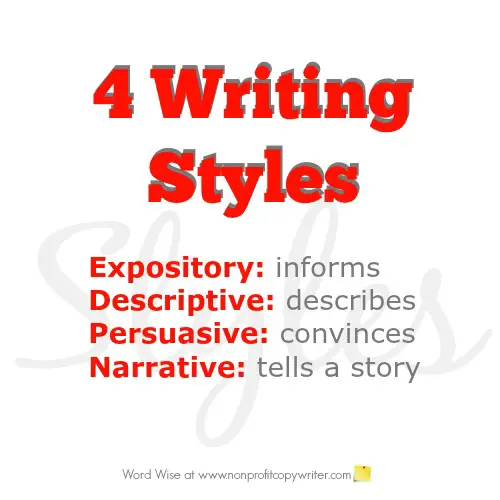Save Time: Get 5 Simple Writing Tips
you can put to use in 10 minutes
4 Writing Styles: When to Use Each One
Award-winning writer Kathy Widenhouse has helped hundreds of nonprofits and writers produce successful content , with 750K+ views for her writing tutorials. She is the author of 9 books. See more of Kathy’s content here.
I admit it: when I first started writing, the idea of
different writing styles not only confused me but intimidated me.
“I’m barely learning the craft,” I thought to myself. From where I sat, I could not envision developing my own style.
Then I learned that there are two ways to look at styles.
1. A writer’s style: an individual writer’s tone and manner sometimes called the “writer’s voice.” There are as many individual styles as there are writers.
2. Writing styles: different kinds of writing that fulfill different purposes. All writing falls into one of four types: expository, descriptive, persuasive, and narrative. Each of these four types has a specific purpose.
This is helpful information. Once I came to understand and master the basics of each type of writing style, I could save time and write better.
You can too.
4 Writing Styles Explained: It’s All About Purpose
As you prepare to write a project, ask yourself this: "What is the purpose of this project?"
Your answer will help you focus your content and approach.
1. Expository Writing: Writing to Explain or Inform
Your purpose: inform your reader about a subject. You give facts and explanations, often as a process or in a logical order. Opinions? No.
Where to Use Expository Writing
How-to articles, news stories, instructions, textbooks, business writing, technical writing, scientific writing, academic writing, recipes
2. Descriptive Writing: Writing to Describe
Your purpose: describe a person, place, thing, or event using details. You use words to paint a picture often with the senses: what you see, hear, taste, smell, feel, or touch.
Where to Use Descriptive Writing
Anecdotes, fiction, poetry, journals, nature writing, travel pieces.
3. Persuasive Writing: Writing to Convince or Sway
Your purpose: to convince the reader. You use reasons, arguments, and justifications to persuade the reader to embrace an idea or viewpoint. Persuasive writing often includes a call to action, aiming to get the reader to take a step.
Where to Use Persuasive Writing
Copywriting, advertising, opinion pieces, editorials, sales letters, cover letters, reviews, job applications, blog posts
4. Narrative Writing: Writing to Tell a Story
Your purpose: to tell a story. You use characters, conflict, and dialogue to lead the reader through a beginning, middle, and an end. Narrative writing answers the question: “What happened then?”
Where to Use Narrative Writing
Storytelling, fiction, poetry, biographies, human interest stories, anecdotes, novels, short stories
More Than One Style of Writing in the Same Piece?
Choose a style for each piece you write by asking, “What is the purpose of this piece – to inform, to describe, to persuade, or to tell a story?”
But along the way, give yourself grace to use elements of all four types of writing to achieve that purpose. Writing styles bleed into each other.
For instance, the main purpose of a blog post is to persuade. But you might use elements of all four types of writing to achieve that end, like this:
You open the post by describing an event you attended that brought an issue to your attention (descriptive writing) and an anecdote from that experience (narrative writing.) You move into a short paragraph that puts forth your view on the subject (persuasive writing.) A section follows that gives facts and information to support your point (expository writing) and you wrap up with a takeaway for your reader to convince her to take action (persuasive writing.)
Choose a style for a piece. But don’t get hung up on it.
More Tips about the Writing Process
The Writing Process: The Key to Writing Faster and Better ...
3 Tips for Starting Your Writing Project ...
How to Set and Achieve a Writing Goal ...
7 Different Types of Content Writing You Need to Master ...
Where to look for writing ideas ...
Capturing ideas for writing projects: a system is the solution ...
How to find the main idea of your piece before you write ...
How to Write a Thesis Statement ...
Pre-Writing: 4 Easy Steps to Make Your Writing Go Faster ...
How to Write an Introduction (or Lead, Lede, Hook) ...
Tips about the Writing Process on our Pinterest board ...
Return from 4 Writing Styles to Nonprofit Copywriter home
As an Amazon Associate I earn from qualifying purchases.
Share This Page

Named to 2022 Writer's Digest list
BEST GENRE/NICHE WRITING WEBSITE


Stop Wasting Time!
Grab your exclusive FREE guide, "5 Simple Writing Tips You Can Put to Use in 10 Minutes or Less"












